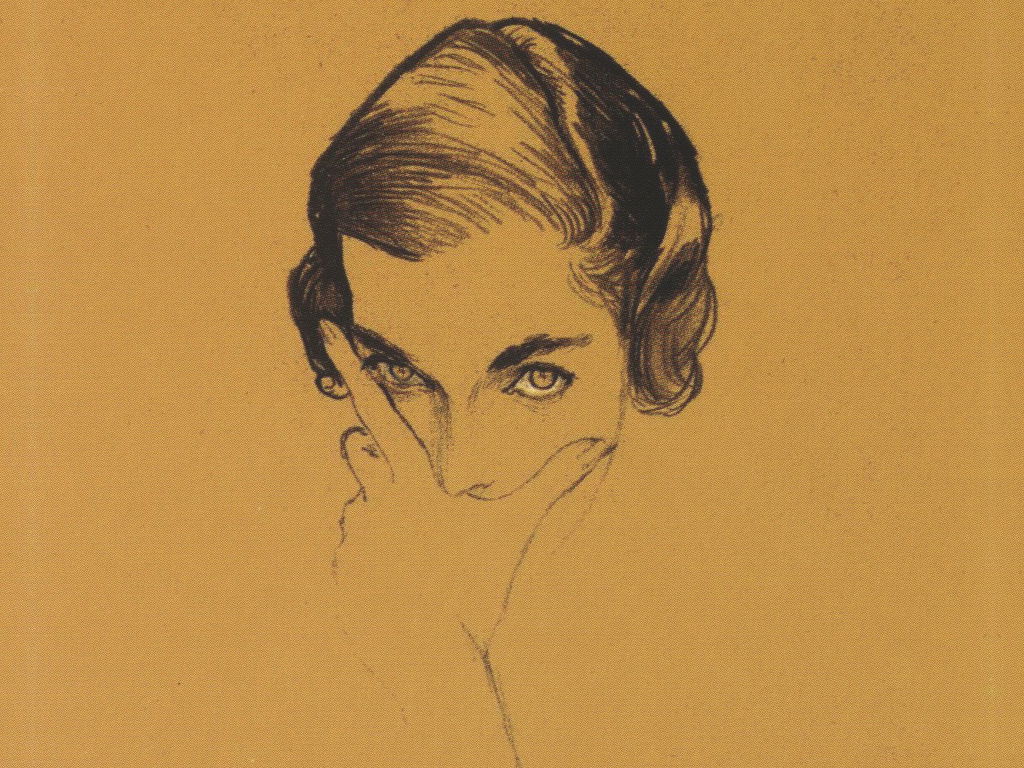
Un’icona glamour
di Silvia Baldassarre
Certe alchimie nascono per uno sguardo, un’immagine, un profumo. A volte per una semplice sensazione. E proprio una sensazione fece capire a Mona Bismarck che lo spettacolo che i suoi occhi stavano ammirando sarebbe stato l’inizio di una lunga storia d’amore, quella con Capri.
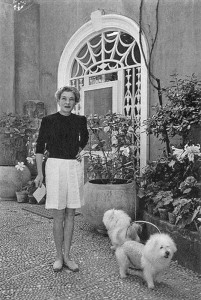 Un brivido lungo la schiena la avvisava ogni volta che qualcosa di importante stava per avvenire nella sua vita, e quel brivido lo avvertì quando vide Capri per la prima volta, nel 1926, dal ponte dello yacht Warrior considerato allora, con i suoi 73 metri, la barca da diporto più grande del suo tempo.
Un brivido lungo la schiena la avvisava ogni volta che qualcosa di importante stava per avvenire nella sua vita, e quel brivido lo avvertì quando vide Capri per la prima volta, nel 1926, dal ponte dello yacht Warrior considerato allora, con i suoi 73 metri, la barca da diporto più grande del suo tempo.
Mona si innamorò dell’isola, delle sue atmosfere e dei suoi paesaggi così come della popolazione e decise impulsivamente di acquistare una proprietà in quel luogo da sogno tanto differente dalle sue magnifiche dimore degli Stati Uniti e di Parigi. Certo quella non era un’abitazione qualunque, i capresi la chiamavano “Il Fortino”, ed era stata fatta costruire a metà dell’Ottocento dal pittore ungherese Hahn che, come tanti in tutti i tempi, aveva scelto Capri come luogo d’elezione.
Il nome “Il fortino” si doveva al fatto che la costruzione del corpo principale era avvenuta durante l’occupazione franco-inglese dell’isola sulle rovine di una fortificazione preesistente risalente al 1806-1816. Il nucleo principale, invece, risaliva addirittura ai tempi dell’imperatore Augusto.
Durante quel suo primo soggiorno sull’isola Mona si affidò a Costanzo, un tuttofare del luogo con cui rimase d’accordo per avere notizie del Fortino, ma che solo dieci anni dopo la rintracciò per comunicarle che la villa di cui si era innamorata era finalmente in vendita.
Ma chi era Mona Bismarck?
Nata nel 1897 a Louisville, nel Kentucky, Edmona Margaret Travis Strader, per tutti Mona, era la figlia di un addestratore di cavalli. Le privazioni vissute in giovane età e le difficoltà familiari, soprattutto affettive, le donarono un carattere forte e risoluto e, come raccontano le cronache del tempo, occhi di ghiaccio, magnetici e difficili da sostenere. Capì da subito che l’unica possibilità che aveva per cambiare la sua vita sarebbe stato un matrimonio ben riuscito e lo capì talmente bene che furono addirittura cinque i mariti che ebbe nell’arco della sua vita.
Il primo fu Henry J. Schlesinger che la condusse dalla campagna alla città, da lui ebbe un figlio da cui si allontanò dopo la separazione, si racconta, per una cifra cospicua donatale dal suocero.
Al secondo marito, James Irving Bush, Mona deve il trasferimento a New York e poi Parigi e all’incontro con la moda di Coco Chanel che si adattava perfettamente alla sua figura e al suo spirito.
Mona aveva un’innata capacità di seduzione, mista ad una buona dose di spregiudicatezza, condita con un po’ di egoismo e pochi vincoli morali, qualità che le consentirono di essere sempre indipendente e libera. Era anche intelligente e con un gusto spiccato per la moda, l’arredamento e la bellezza in generale, qualità che le consentirono di vincere, nel 1933, il titolo di “Donna meglio vestita al mondo”. Per la prima volta da quando il premio era stato istituito nel 1922 una donna non europea e non francese soprattutto, si era aggiudicata il tanto ambito premio votata da stilisti del calibro di Chanel, Molyneux, Vionnet, Lelong, e Lanvin.
Con il terzo marito, Harrison Williams, il patrimonio e la ricchezza crebbero in maniera esponenziale, Mona continuò negli anni a ricevere il premio di “Donna meglio vestita al mondo” diventando così una vera e propria icona glamour e intorno a sé e alle sue dimore, ristrutturate e arredate con gusto principesco, gravitava una folta schiera di personaggi in vista dell’alta società americana e non solo.
Con Harrison comprò e ristrutturò diverse abitazioni tra cui quella caprese nel 1936. La Capri che Mona aveva ritrovato era completamente diversa rispetto a quella di dieci anni prima.
Nella sua nuova villa Mona decise di cimentarsi in autonomia nella ristrutturazione e nell’arredamento e non si affidò, come aveva sempre fatto in precedenza, ad architetti o arredatori di mestiere. Condivise invece le scelte con un caro amico, il conte Albrecht Edzard Heinrich Karl von Bismarck-Schönhausen, nipote del cancelliere tedesco Otto von Bismarck ma che per Mona era semplicemente Eddie, affidandosi alla sua raffinatezza e ricercatezza, oltre che alla sua grande cultura, lei in fondo rimaneva pur sempre una ragazza del Kentucky. Il giardino, soprattutto, divenne il luogo dove dare sfogo a tutto il suo buon gusto e la villa caprese divenne per lei un buen retiro.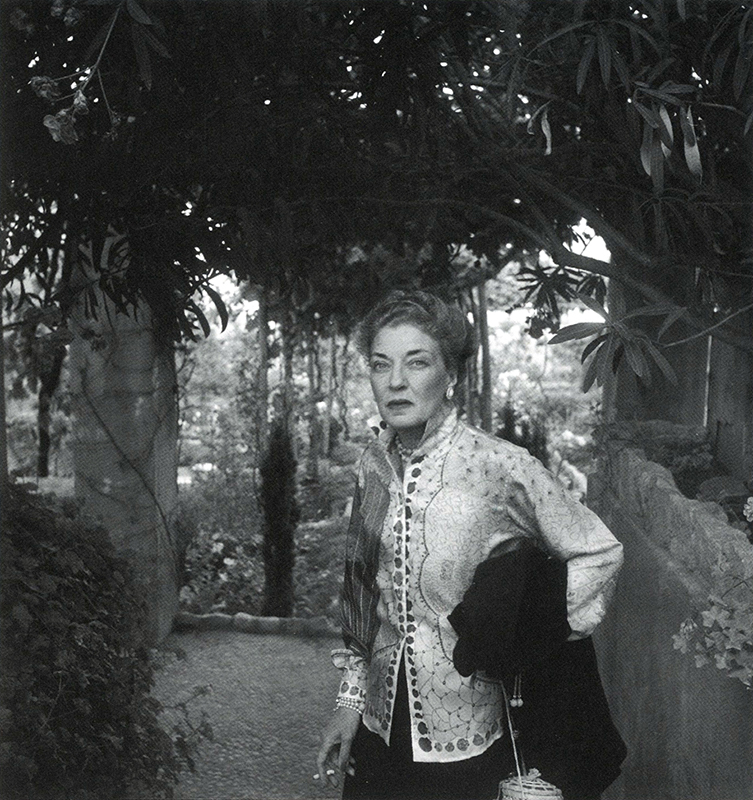
La sera dell’inaugurazione nacque il mito caprese di Mona. Invitò circa 500 persone, tutte le maestranze che avevano partecipato alla ristrutturazione della casa insieme alle loro famiglie. Offrì loro ogni prelibatezza, lei si presentò sul finire della festa per rendere omaggio ai suoi ospiti, poi si ritirò all’interno della casa, per una festa privata e di sicuro più esclusiva.
Eddie le rimase per sempre amico e fu lui, dopo la morte di Harrison Williams, a divenire il suo quarto marito. In fondo cosa mancava ad una donna che aveva tutto se non un titolo nobiliare?
Divenne così, per tutti, Mona von Bismarck e quando dopo la morte prematura del quinto marito capì di essere stata scelta solo per una mera questione economica, volle tornare a quel nome che, oltre ad esserle sempre caro, le assegnava anche il titolo di contessa.
È con questo nome che ancora oggi la ricordano in tanti insieme al suo buon gusto, al suo stile unico e al suo grande amore per Capri.
Storia di una vita straordinaria
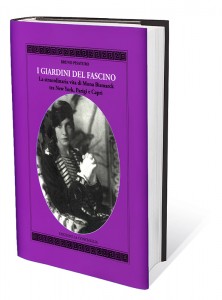 È una biografia particolarmente accurata quella scritta da Bruno Pisaturo e pubblicata da La Conchiglia (I giardini del fascino. La straordinaria vita di Mona Bismarck tra New York, Parigi e Capri) che racconta le vicende pubbliche e private di una donna che, con il suo fascino e il suo gusto è divenuta un’icona di stile. La storia di Mona von Bismarck è quella di una Cenerentola che riuscì ad emergere lasciando un segno indelebile del suo passaggio. E se oggi le nuove generazioni non la ricordano o addirittura ne ignorano l’esistenza, lo stesso non si può dire per i luoghi in cui ha vissuto. Soprattutto a Capri la sua bellissima dimora è oggi adibita a residenza privata e in parte ad un resort di lusso nel quale rivivono alcuni elementi originali restaurati o ben conservati. Il volume è arricchito da un portfolio fotografico che ripercorre la vita straordinaria di una donna il cui nome è sinonimo di fascino, stile e gusto singolare. | Story of an extraordinary life. The biography by Bruno Pisaturo, published by La Conchiglia (I giardini del fascino. La straordinaria vita di Mona Bismarck tra New York, Parigi e Capri) is detailed and comprehensive, telling the story of the public and private life of a woman whose charm and good taste made her into a style icon. The story of Mona von Bismarck is the Cinderella story of a woman who managed to rise above her poor beginnings to leave an indelible impression of her path through life. While the younger generations may not remember her or may never have heard of her, you cannot say the same for the places that she lived in. Particularly on Capri, where her beautiful home has been turned into a private residence and in part, a luxury resort, bringing back to life some of the original elements that have been restored or were well-preserved. The book is illustrated with a collection of photos tracing the remarkable life of a woman whose name was synonymous with fashion, style and exceptional good taste.
È una biografia particolarmente accurata quella scritta da Bruno Pisaturo e pubblicata da La Conchiglia (I giardini del fascino. La straordinaria vita di Mona Bismarck tra New York, Parigi e Capri) che racconta le vicende pubbliche e private di una donna che, con il suo fascino e il suo gusto è divenuta un’icona di stile. La storia di Mona von Bismarck è quella di una Cenerentola che riuscì ad emergere lasciando un segno indelebile del suo passaggio. E se oggi le nuove generazioni non la ricordano o addirittura ne ignorano l’esistenza, lo stesso non si può dire per i luoghi in cui ha vissuto. Soprattutto a Capri la sua bellissima dimora è oggi adibita a residenza privata e in parte ad un resort di lusso nel quale rivivono alcuni elementi originali restaurati o ben conservati. Il volume è arricchito da un portfolio fotografico che ripercorre la vita straordinaria di una donna il cui nome è sinonimo di fascino, stile e gusto singolare. | Story of an extraordinary life. The biography by Bruno Pisaturo, published by La Conchiglia (I giardini del fascino. La straordinaria vita di Mona Bismarck tra New York, Parigi e Capri) is detailed and comprehensive, telling the story of the public and private life of a woman whose charm and good taste made her into a style icon. The story of Mona von Bismarck is the Cinderella story of a woman who managed to rise above her poor beginnings to leave an indelible impression of her path through life. While the younger generations may not remember her or may never have heard of her, you cannot say the same for the places that she lived in. Particularly on Capri, where her beautiful home has been turned into a private residence and in part, a luxury resort, bringing back to life some of the original elements that have been restored or were well-preserved. The book is illustrated with a collection of photos tracing the remarkable life of a woman whose name was synonymous with fashion, style and exceptional good taste.
Glamour icon
by Silvia Baldassarre
Sometimes an alchemy may be sparked by a glance, an image or a perfume. And sometimes it is just a feeling. It was such a feeling that made Mona Bismarck realise that the spectacle she was gazing at in admiration would be the start of a long love story: her love story with Capri.
She always felt a shiver run up her spine whenever something important was about to happen in her life, and she felt that shiver when she saw Capri for the first time in 1926, from the deck of the yacht Warrior, at 73 metres believed to be the largest yacht in the world at the time.
Mona fell in love with the island, with its atmospheres, its landscapes and its people, and she decided on impulse to buy a house in that place of dreams, so different from her magnificent residences in the USA and Paris. For sure, it was no ordinary house: the Capri inhabitants called it “Il Fortino” (the Little Fort), and it had been built in the mid 19th century for the Hungarian artist Hahn, who, like many others at different times, chose Capri for his home.
The name “Il Fortino” derived from the fact that the main building was constructed during the Franco-British occupation of the island, on the ruins of a pre-existing fort dating back to 1806-1816. But the inner core of the building dated back to the time of the emperor Augustus.
During her first stay on the island Mona put her trust in a local handyman called Costanzo, with whom she had an agreement that he would keep her informed about the Fortino, but it was not for another ten years that he contacted her with the news that the villa she had fallen in love with was finally up for sale.
So who was Mona Bismarck?
Born in 1897 in Louisville, Kentucky, Edmona Margaret Travis Strader, known to everyone as Mona, was the daughter of a horse trainer. The hardships and family difficulties that she experienced in her youth, particularly the emotional suffering, led her to develop a strong, resolute character and, as the society newspapers of the time tell us, ice-cold eyes with a magnetic appeal that was difficult to withstand. She realised immediately that the only opportunity she would have to change her life would be to make a good marriage, something she understood so well that she ended up having five husbands during her lifetime.
The first was Henry J. Schlesinger who took her from the countryside to the city, and with whom she had a son; after the couple separated, she distanced herself from her son, allegedly in return for a substantial sum given to her by her father-in-law.
Mona’s second husband, James Irving Bush, took her to New York and later Paris, where she encountered the fashions of Coco Chanel, so perfectly suited to her figure and her spirit.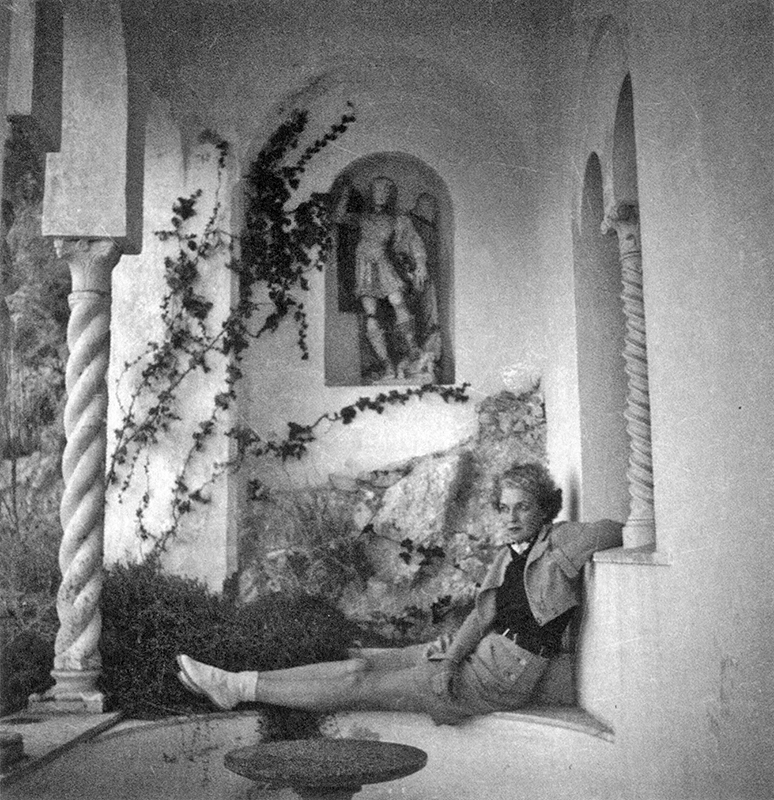
Mona had an innate ability to seduce, combined with a complete lack of inhibition, a touch of egoism and few moral restraints, qualities that allowed her to be always free and independent. She was intelligent, too, and had a strong interest in fashion, furnishings and beauty in general, which contributed to her winning the title of ‘Best dressed woman in the world’ in 1933. It was the first time since the prize was set up in 1922 that a non-European, and more particularly a non-French woman, had won this much-coveted award, based on votes from designers such as Chanel, Molyneux, Vionnet, Lelong, and Lanvin.
With her third husband, Harrison Williams, Mona’s wealth and fortune grew exponentially. She continued over the years to receive the “Best dressed woman in the world” award, becoming a true glamour icon, and together with her houses, refurbished and furnished in magnificent style, she attracted a large crowd of high society celebrities from the USA and other countries.
With Harrison, Mona bought and renovated several different houses, including the one on Capri in 1936. The island that Mona had returned to was completely different from the Capri of ten years earlier.
Mona decided to try undertaking all the restoration and furnishing of her new villa by herself, without entrusting it to professional architects or interior designers as she had always done in the past. Instead, she shared her choices with a dear friend, Count Albrecht Edzard Heinrich Karl von Bismarck-Schönhausen, grandson of the German chancellor Otto von Bismarck; for Mona he was simply Eddie, and she trusted in his refinement and sophistication, as well as his great culture, while she always remained a Kentucky girl. Her garden, in particular, became the place where she could give free rein to her good taste and style, and the Capri villa became a buen ritiro, or lovely retreat, for her.
The evening of its inauguration was when the Capri Mona legend began. She invited about 500 people, including all the craftsmen who had taken part in restoring the house, together with their families. They were offered all kinds of delicacies, and Mona arrived at the end of the feast to pay homage to her guests, after which she retired inside the house for a more private, and certainly more exclusive party.
Eddie always remained a friend of hers, and on the death of Harrison Williams, he became her fourth husband. After all, what could a woman who had everything lack, other than an aristocratic title?
And so she became to everyone Mona von Bismarck, and when, after the premature death of her fifth husband, she realised that he had only chosen her for her money, she decided to go back to that name that, apart from always being dear to her, gave her the title of Countess.
That is the name that many still remember her by today, along with her good taste, her unique style and her great love for Capri.





